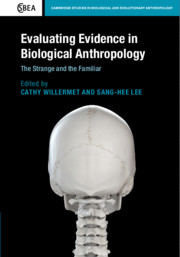Book contents
- Evaluating Evidence in Biological Anthropology
- Cambridge Studies in Biological and Evolutionary Anthropology
- Evaluating Evidence in Biological Anthropology
- Copyright page
- Contents
- Contributors
- Introduction
- Part I The Strange and the Familiar
- Part II (Re)Discovery of Evidence
- 6 (Re)Discovering Paleopathology
- 7 Parsing the Paradox
- 8 Seeing RED
- 9 Paleoanthropology and Analytical Bias
- 10 (Re)Discovering Ancient Hominin Environments
- 11 Discussion and Conclusion
- Index
- References
6 - (Re)Discovering Paleopathology
Integrating Individuals and Populations in Bioarchaeology
from Part II - (Re)Discovery of Evidence
Published online by Cambridge University Press: 01 November 2019
- Evaluating Evidence in Biological Anthropology
- Cambridge Studies in Biological and Evolutionary Anthropology
- Evaluating Evidence in Biological Anthropology
- Copyright page
- Contents
- Contributors
- Introduction
- Part I The Strange and the Familiar
- Part II (Re)Discovery of Evidence
- 6 (Re)Discovering Paleopathology
- 7 Parsing the Paradox
- 8 Seeing RED
- 9 Paleoanthropology and Analytical Bias
- 10 (Re)Discovering Ancient Hominin Environments
- 11 Discussion and Conclusion
- Index
- References
Summary
The past decade has been a time of significant growth in paleopathology, and also a time of transition in the relationship between paleopathology – “the investigation of diseases and related conditions in skeletal and soft tissue remains” (Paleopathology Association 2018) – and the broader field of bioarchaeology – the “integrative, contextualized study of human skeletal remains derived from archaeological settings” (Larsen 2018:865). These trends are driving a real florescence in paleopathology as this work, which starts from the study of individual bones, finds an integral role in larger-scale contextualized explorations of life in the past (Buzon 2012; Grauer 2018a, 2018b). In this chapter, we review the underpinnings of the enhanced articulation of paleopathology and bioarchaeology, especially in regard to studies of disability and care. We address the difficulties attendant to discussions of disability that stem from the epistemologies and semantics of disability studies and the cross-cultural (and temporal) differences in the experience of illness, the perceived sources of illness, and attitudes toward the ill or disabled. These are significant issues in contemporary society and global epidemiology, as well as in the interpretation of pathologies identified in skeletal and soft tissue remains. Returning to the role of paleopathology, we review current approaches to quantifying impairment and interpreting disability in the bioarchaeological record, highlighting the role of interpreting evidence for the provision (and withholding) of care – care of the very young and the very old, of the ill and disabled, and care of the dead – as a bridge between paleopathology and the broader studies that represent significant developments in bioarchaeology.
- Type
- Chapter
- Information
- Evaluating Evidence in Biological AnthropologyThe Strange and the Familiar, pp. 103 - 125Publisher: Cambridge University PressPrint publication year: 2019



